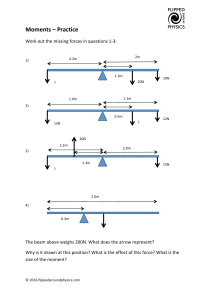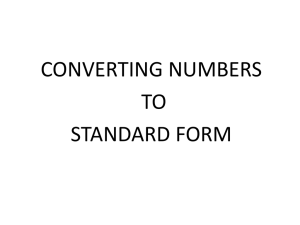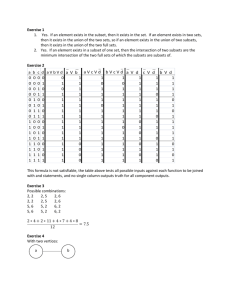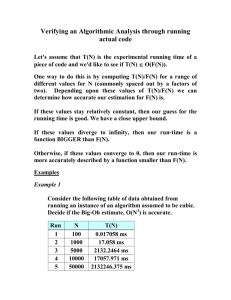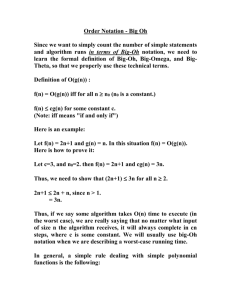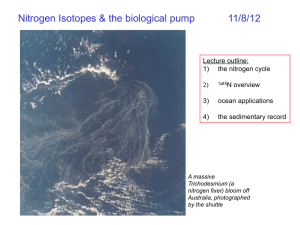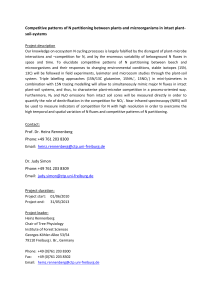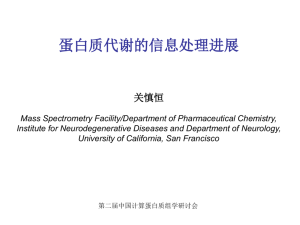Homework solutions Math526 Spring 2004 Text book: Bickel
advertisement
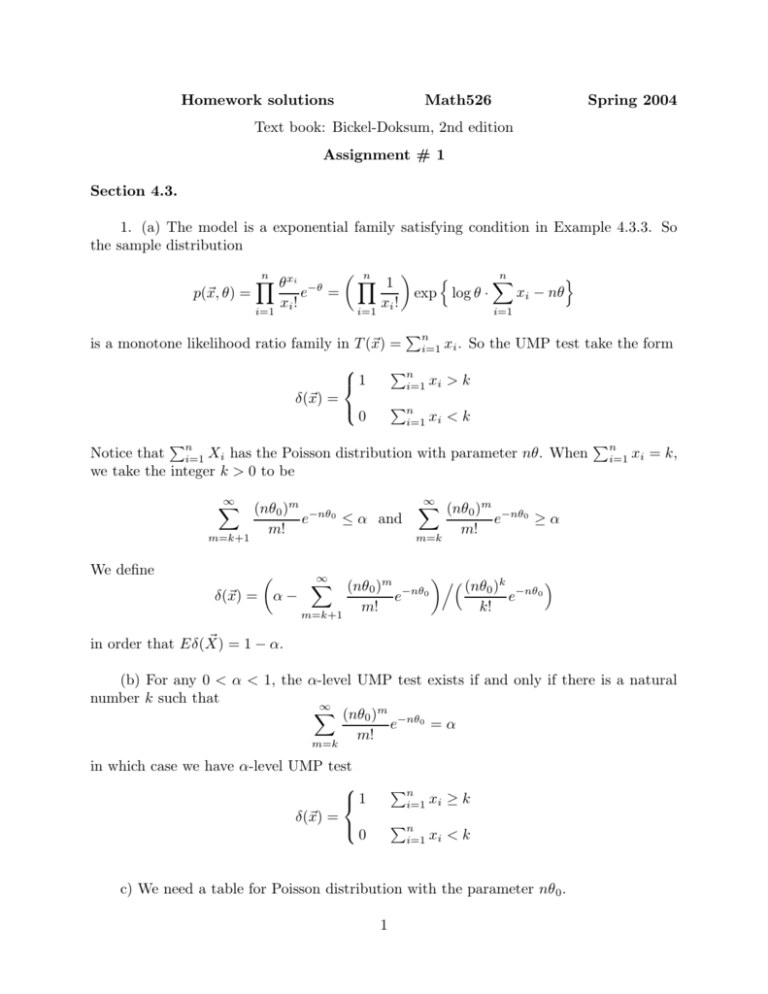
Homework solutions Math526 Spring 2004 Text book: Bickel-Doksum, 2nd edition Assignment # 1 Section 4.3. 1. (a) The model is a exponential family satisfying condition in Example 4.3.3. So the sample distribution Y n n n o n X Y θ xi −θ 1 xi − nθ e = p(~x, θ) = exp log θ · xi ! xi ! i=1 i=1 i=1 is a monotone likelihood ratio family in T (~x) = δ(~x) = i=1 Pn 1 Pn i=1 Pn 0 i=1 xi . So the UMP test take the form xi > k xi < k Pn Pn Notice that i=1 Xi has the Poisson distribution with parameter nθ. When i=1 xi = k, we take the integer k > 0 to be ∞ X (nθ0 )m −nθ0 e ≤ α and m! ∞ X (nθ0 )m −nθ0 e ≥α m! m=k+1 We define δ(~x) = m=k ∞ X (nθ0 )m −nθ0 . (nθ0 )k −nθ0 α− e e m! k! m=k+1 ~ = 1 − α. in order that Eδ(X) (b) For any 0 < α < 1, the α-level UMP test exists if and only if there is a natural number k such that ∞ X (nθ0 )m −nθ0 e =α m! m=k in which case we have α-level UMP test 1 δ(~x) = 0 Pn i=1 Pn i=1 xi ≥ k xi < k c) We need a table for Poisson distribution with the parameter nθ0 . 1 2. We have α = 0.01. 0.01 = sup Pθ θ≤10 = P10 n 1 √ 10n n nX o Xi ≥ kα = P10 i=1 n X n nX i=1 Xi ≥ k α o k − 10n kα − 10n o α (Xi − 10) ≥ √ ≈1−Φ √ 10n 10n i=1 Hence kα − 10n √ = z(0.99) = 2.33 10n On the other hand, 0.99 = inf Pθ θ≥15 n = P15 √ Hence n nX o Xi ≥ kα = P15 i=1 1 15n n X i=1 (Xi − 15) ≥ n nX i=1 Xi ≥ k α o k − 15n kα − 15n o α √ ≈1−Φ √ 15n 15n kα − 15n √ = z(0.01) = −z(0.99) = −2.33 15n So we have We have n= √ kα − 10n = 2.33 √ 10n kα − 15n = −2.33 15n √ √ 2 2.33 · ( 10 + 15) ≈ 10.75 5 So we take n = 11. 6. (a). µ= Z ∞ c x · cθ θx−(1+θ) dx = c θ θ−1 The probelm is to test H: θ = θ0 versus K: θ > θ0 , where θ0 = The sample density p(~x, θ) = cnθ θ n n Y −(1+θ) xi = cn exp i=1 is a MLR family in T (~x) = − Pn n − (1 + θ) log xi . Hence, T (~x) ≥ k 1, δ(~x) = 0, T (~x) < k i=1 2 n X i=1 µ0 µ0 −c (notice that µ0 > c). log xi + n log θ o where k satisfies ~ ≥k =α Pθ0 T (X) To compute its value, we use central limit theorem that claims that q ~ − ET (X) ~ / V ar(T (X) ~ T (X) converges to N (0, 1) in distribution as n → ∞. Let η = 1 + θ n o ~ + n log(η − 1) p(~x, θ) = cn exp ηT (X) By Theorem 1.6.2, ~ = n log(η − 1) ET (X) 0 = n n = η−1 θ n 0 n n ~ = 2 V ar T (X) = = 2 η−1 (η − 1) θ Hence, α = P θ0 So we take Therefore, n T (X) k− n ~ − n k − nθ o θ0 θ0 √ ≥ ≈ 1 − Φ √ −1 −1 √ θ −1 n θ0 n θ0 n k − θn0 √ = z(1 − α) θ0−1 n i µ − ch i h √ √ 0 n + nz(1 − α) k = θ0−1 n + nz(1 − α) = µ0 3
